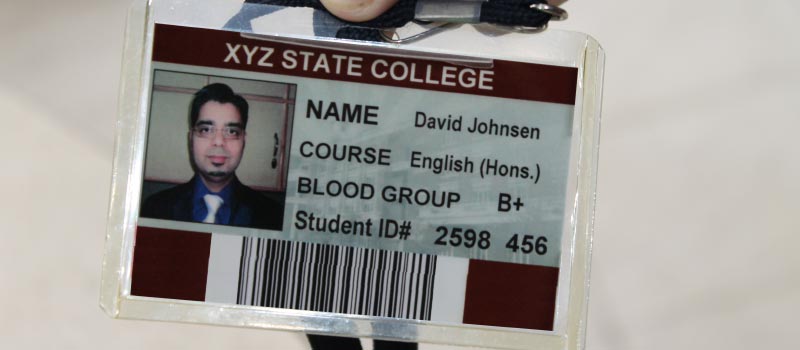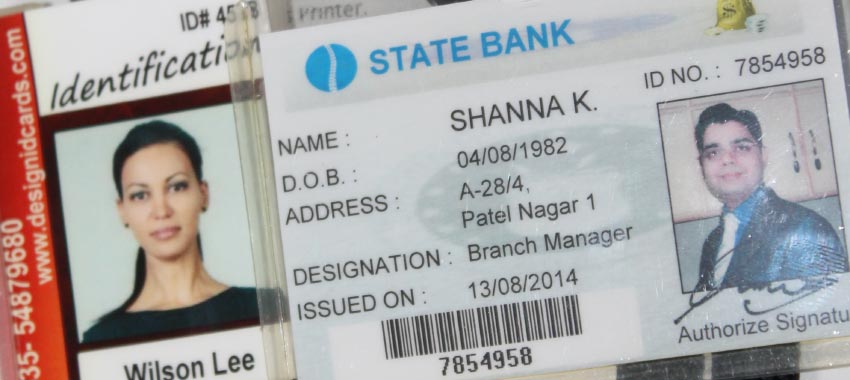Include a Company Logo or Branding in my ID Badge Design
Including a company logo or branding in an ID badge design is a common practice and can be beneficial for several reasons. Here are some details explaining why and how you can include a company logo or branding in your ID badge design:

-
Identification:
An ID badge is primarily used to identify individuals within an organization. By incorporating the company logo or branding into the badge design, it becomes easier for others to recognize the affiliation of the badge wearer with the company. It helps create a visual connection between the person and the organization they represent.
-
Professionalism and Branding:
Including the company logo on the ID badge enhances the overall professionalism of the design. It creates a cohesive and consistent look across the organization, reinforcing the company's brand identity. A well-designed badge with the logo can also instill a sense of pride and belonging among employees.
-
Security:
Adding the company logo or branding to an ID badge can contribute to its security features. A visually recognizable logo helps distinguish authentic badges from counterfeit ones, reducing the risk of unauthorized access or security breaches. Additionally, including a logo can make it easier for security personnel to identify individuals within the organization quickly.
Some Important Considerations when Incorporating a Company Logo
When incorporating a company logo or branding into an ID badge design, here are some important considerations:
-
Placement
The logo should be placed prominently on the badge, ideally at the top or center where it can be easily seen. It should be large enough to be visible from a reasonable distance, ensuring quick identification.
-
Size and Scale
The logo should be scaled appropriately to maintain a balanced and visually appealing design. It should neither overwhelm the badge nor be too small to recognize.
-
Colors
Ensure that the logo's colors are compatible with the overall design scheme of the badge. The colors should be visually pleasing, and if necessary, they can be adjusted to fit the badge's color palette.
-
Legibility
The logo should be clear and legible, even when reduced in size. Make sure the logo doesn't lose its readability or become distorted when incorporated into the badge design.
-
Design Harmony
The logo should blend harmoniously with the rest of the badge design elements, such as the employee's name, photo, job title, and any other relevant information. Aim for a cohesive design that brings together all the elements in a visually appealing manner.
Remember to comply with any brand guidelines or usage rules provided by the company when incorporating the logo into the ID badge design. These guidelines might specify aspects such as minimum size requirements, color variations, or restrictions on altering the logo.
Conclusion: Overall, including a company logo or branding in an ID badge design is an effective way to enhance identification, promote professionalism, and reinforce brand identity within an organization.
Include Personalization in your ID Badge Design
Personalization is a crucial aspect of ID badge design, as it helps identify and distinguish individuals within an organization. Including the employee's name and photo on the badge adds a level of individuality and enhances security. Here's a detailed explanation of how personalization can be incorporated into ID badge design:
-
Employee Name:
Including the employee's name on the ID badge is fundamental. It allows others to address the employee correctly and creates a sense of ownership and belonging. The name can be prominently displayed on the badge, usually below or beside the employee's photo, using a legible font size and style that ensures easy readability.
-
Employee Photo:
Adding the employee's photo to the ID badge is an effective way to visually associate the badge with the individual. The photo should be clear, well-lit, and recent to ensure easy identification. Placing the photo prominently on the badge, typically in the upper or left-hand corner, allows others to quickly verify the person's identity. It's important to ensure the photo is large enough, so facial features are distinguishable, while maintaining an appropriate balance with other design elements.
-
Personalized Design:
Beyond the employee's name and photo, personalization can extend to the overall design of the badge. This can involve incorporating the company's logo, brand colors, or other personalized elements. The design should align with the organization's branding guidelines while reflecting the individual's role or department. For example, different colors or icons can be used to differentiate employees from various departments or levels within the organization.
-
Variable Data Printing:
To streamline the personalization process for large organizations with numerous employees, variable data printing (VDP) can be utilized. VDP allows for the efficient printing of personalized information, such as names and employee numbers, directly onto each badge. This eliminates the need for manual insertion or attachment of individual labels or stickers, ensuring accuracy and consistency throughout the badge production process.
-
Security Considerations:
Personalization plays a vital role in enhancing ID badge security. By including the employee's name and photo, the badge becomes harder to counterfeit or misuse. It enables quick visual verification of the badge holder's identity, reducing the risk of unauthorized access. Additionally, some organizations may choose to include additional security features like holograms, barcodes, or RFID technology to further enhance authentication and access control.
-
Design Constraints:
When incorporating personalization, it's important to consider the size and layout of the badge. Ensure that the employee's name and photo are sized appropriately to maintain legibility and clarity. Consider the available space on the badge and balance it with other necessary information, such as job title, company name, and any required security features. Maintaining a clean and uncluttered design while accommodating personalization is key.
Conclusion: By incorporating personalization through employee names and photos, ID badges become more than just identification tools—they become a representation of the individuals within the organization. This personal touch enhances security, fosters a sense of belonging, and facilitates quick and accurate identification, contributing to a safe and efficient work environment.
Different Layout options for ID Badge Design

-
Horizontal Layout:
In this layout, the ID badge is designed to be wider than it is tall. The information is arranged from left to right, with the person's photo usually placed on the left side and the text on the right. This layout is often used when there is a need for a larger photo or when there is a significant amount of text to be included, such as job title, department, and company name.
-
Vertical Layout:
In contrast to the horizontal layout, the vertical layout is taller than it is wide. The information is arranged from top to bottom, with the photo typically placed at the top followed by the text. This layout is commonly used when there is limited horizontal space available, or when a more compact design is desired. It can work well for badges that will be worn on lanyards.
-
Full-Bleed Layout:
Full-bleed refers to a design where the background color, image, or pattern extends to the edges of the badge, without any margins or borders. This layout can create a visually striking effect and is often used when a modern and attention-grabbing design is desired. However, it's important to ensure that important information doesn't get cut off or obscured near the edges.
-
Framed Layout:
In this layout, the badge is enclosed within a border or frame. The frame can be a simple line, a solid color border, or a decorative design element. This layout provides a clear boundary for the badge and can help draw attention to the content within. It is commonly used when there is a need to distinguish the badge from its surroundings or to create a more formal and professional look.
-
Tabbed Layout:
A tabbed layout involves adding tabs or sections to the badge design, creating distinct areas for different information. Tabs can be positioned vertically or horizontally and are often used to separate personal information, company details, and access credentials. This layout can help organize the information and make it easier to locate specific details on the badge.
-
Custom Layout:
The layout options mentioned above are just a few examples, and there is no limit to the creativity and customization that can be applied to ID badge design. Custom layouts involve unique arrangements of elements, such as asymmetrical designs, overlapping elements, or creative use of shapes and patterns. This allows for a more personalized and visually appealing badge design that aligns with specific branding or thematic requirements.
In addition to the layout, other design considerations include font choice, color scheme, logo placement, and any additional security features like holograms or barcodes. It's essential to strike a balance between aesthetics, readability, and the functional requirements of the ID badge to ensure it effectively serves its purpose while reflecting the desired brand image.